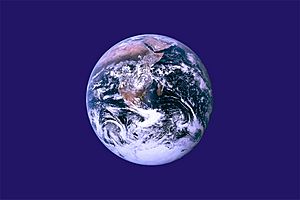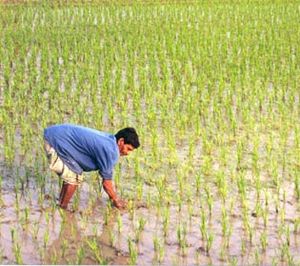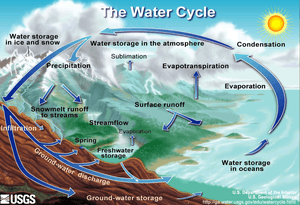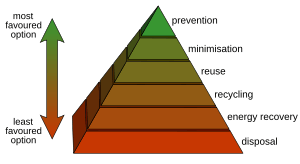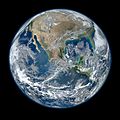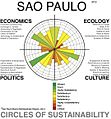Sustainability facts for kids
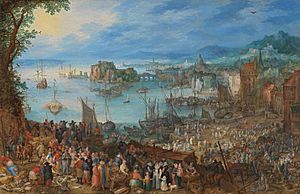
Sustainability means that a process or state can be maintained at a certain level for as long as is wanted. In the 21st century, it refers generally to how the Earth and humans can co-exist.
The study of ecology believes that sustainability is achieved through the balance of species and the resources within their environment. To maintain this equilibrium, available resources must not be depleted faster than resources are naturally generated.
Healthy ecosystems and environments are necessary to the survival of humans and other organisms. Ways of reducing negative human impact are environmentally-friendly chemical engineering, environmental resources management and environmental protection. Information is gained from green computing, green chemistry, earth science, environmental science and conservation biology. Ecological economics studies the fields of academic research that aim to address human economies and natural ecosystems.
Ways of living more sustainably can take many forms from reorganizing living conditions (e.g., ecovillages, eco-municipalities and sustainable cities), reappraising economic sectors (permaculture, green building, sustainable agriculture), or work practices (sustainable architecture), using science to develop new technologies (green technologies, renewable energy and sustainable fission and fusion power), or designing systems in a flexible and reversible manner, and adjusting individual lifestyles that conserve natural resources.
Despite the increased popularity of the use of the term "sustainability", the possibility that human societies will achieve environmental sustainability has been, and continues to be, questioned—in light of environmental degradation, climate change, overconsumption, population growth and societies' pursuit of unlimited economic growth in a closed system.
Contents
Environmental dimension
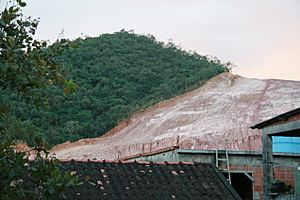
Healthy ecosystems provide vital goods and services to humans and other organisms. There are two major ways of reducing negative human impact and enhancing ecosystem services and the first of these is environmental management. This direct approach is based largely on information gained from earth science, environmental science and conservation biology.
Environmental management
At the global scale and in the broadest sense environmental management involves the oceans, freshwater systems, land and atmosphere, it can also be equally applied to any ecosystem from a tropical rainforest to a home garden.
Atmosphere
Management of the global atmosphere now involves assessment of all aspects of the carbon cycle to identify opportunities to address human-induced climate change and this has become a major focus of scientific research because of the potential catastrophic effects on biodiversity and human communities.
Other human impacts on the atmosphere include the air pollution in cities, the pollutants including toxic chemicals like nitrogen oxides, sulfur oxides, volatile organic compounds and particulate matter that produce photochemical smog and acid rain, and the chlorofluorocarbons that degrade the ozone layer.
Freshwater and oceans
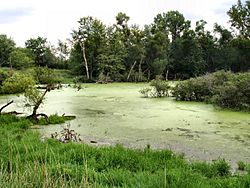
Water covers 71% of the Earth's surface. Of this, 97.5% is the salty water of the oceans and only 2.5% freshwater, most of which is locked up in the Antarctic ice sheet. The remaining freshwater is found in glaciers, lakes, rivers, wetlands, the soil, aquifers and atmosphere. Due to the water cycle, fresh water supply is continually replenished by precipitation, however there is still a limited amount necessitating management of this resource.
Awareness of the global importance of preserving water for ecosystem services has only recently emerged as, during the 20th century, more than half the world’s wetlands have been lost along with their valuable environmental services. Increasing urbanization pollutes clean water supplies and much of the world still does not have access to clean, safe water. Greater emphasis is now being placed on the improved management of blue (harvestable) and green (soil water available for plant use) water, and this applies at all scales of water management.
Ocean circulation patterns have a strong influence on climate and weather and, in turn, the food supply of both humans and other organisms. Scientists have warned of the possibility, under the influence of climate change, of a sudden alteration in circulation patterns of ocean currents that could drastically alter the climate in some regions of the globe. Ten per cent of the world's population – about 600 million people – live in low-lying areas vulnerable to sea level rise.
Land use
Loss of biodiversity stems largely from the habitat loss. Land use change is fundamental to the operations of the biosphere because alterations in the relative proportions of land dedicated to urbanisation, agriculture, forest, woodland, grassland and pasture have a marked effect on the global water, carbon and nitrogen biogeochemical cycles and this can impact negatively on both natural and human systems. At the local human scale, major sustainability benefits accrue from sustainable parks and gardens and green cities.
Food is essential to life. Feeding more than six billion human bodies takes a heavy toll on the Earth’s resources. Environmental problems associated with industrial agriculture and agribusiness are now being addressed through such movements as sustainable agriculture, organic farming and more sustainable business practices.
Management of human consumption
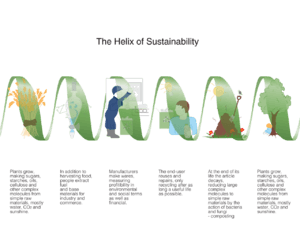
The underlying driver of direct human impacts on the environment is human consumption. This impact is reduced by not only consuming less but by also making the full cycle of production, use and disposal more sustainable.
Key resource categories relating to human needs are food, energy, materials and water.
Energy
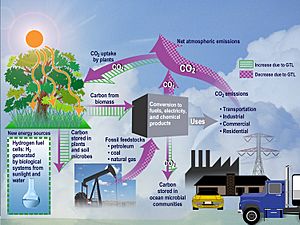
The Sun's energy, stored by plants (primary producers) during photosynthesis, passes through the food chain to other organisms to ultimately power all living processes.
Since the industrial revolution the concentrated energy of the Sun stored in fossilized plants as fossil fuels has been a major driver of technology which, in turn, has been the source of both economic and political power. In 2007 climate scientists of the IPCC concluded that there was at least a 90% probability that atmospheric increase in CO2 was human-induced, mostly as a result of fossil fuel emissions but, to a lesser extent from changes in land use. Stabilizing the world’s climate will require high-income countries to reduce their emissions by 60–90%.
Reducing greenhouse emissions, is being tackled at all scales, ranging from tracking the passage of carbon through the carbon cycle to the commercialization of renewable energy, developing less carbon-hungry technology and transport systems and attempts by individuals to lead carbon neutral lifestyles by monitoring the fossil fuel use embodied in all the goods and services they use.
Water
Water security and food security are inextricably linked. In the decade 1951–60 human water withdrawals were four times greater than the previous decade. This rapid increase resulted from scientific and technological developments impacting through the economy – especially the increase in irrigated land, growth in industrial and power sectors, and intensive dam construction on all continents. This altered the water cycle of rivers and lakes, affected their water quality and had a significant impact on the global water cycle.
Currently towards 35% of human water use is unsustainable, drawing on diminishing aquifers and reducing the flows of major rivers: this percentage is likely to increase if climate change impacts become more severe, populations increase, aquifers become progressively depleted and supplies become polluted and unsanitary.
Water efficiency is being improved on a global scale by increased demand management, improved infrastructure, improved water productivity of agriculture, minimising the water intensity (embodied water) of goods and services, addressing shortages in the non-industrialised world, concentrating food production in areas of high productivity, and planning for climate change. At the local level, people are becoming more self-sufficient by harvesting rainwater and reducing use of mains water.
Food

The American Public Health Association (APHA) defines a "sustainable food system" as "one that provides healthy food to meet current food needs while maintaining healthy ecosystems that can also provide food for generations to come with minimal negative impact to the environment. A sustainable food system also encourages local production and distribution infrastructures and makes nutritious food available, accessible, and affordable to all. Further, it is humane and just, protecting farmers and other workers, consumers, and communities."
Concerns about the environmental impacts of agribusiness and the stark contrast between the obesity problems of the Western world and the poverty and food insecurity of the developing world have generated a strong movement towards healthy, sustainable eating as a major component of overall ethical consumerism. The environmental effects of different dietary patterns depend on many factors, including the proportion of animal and plant foods consumed and the method of food production.
A Mediterranean diet is recommended which is associated with health and longevity and is low in meat, rich in fruits and vegetables, low in added sugar and limited salt, and low in saturated fatty acids; the traditional source of fat in the Mediterranean is olive oil, rich in monounsaturated fat. The healthy rice-based Japanese diet is also high in carbohydrates and low in fat. Both diets are low in meat and saturated fats and high in legumes and other vegetables; they are associated with a low incidence of ailments and low environmental impact.
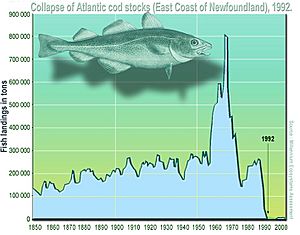
At the global level the environmental impact of agribusiness is being addressed through sustainable agriculture and organic farming. At the local level there are various movements working towards local food production, more productive use of urban wastelands and domestic gardens including permaculture, urban horticulture, local food, slow food, sustainable gardening, and organic gardening.
Sustainable seafood is seafood from either fished or farmed sources that can maintain or increase production in the future without jeopardizing the ecosystems from which it was acquired. The sustainable seafood movement has gained momentum as more people become aware about both overfishing and environmentally-destructive fishing methods.
Materials, toxic substances, waste

As global population and affluence has increased, so has the use of various materials increased in volume, diversity and distance transported. Included here are raw materials, minerals, synthetic chemicals (including hazardous substances), manufactured products, food, living organisms and waste. By 2050, humanity could consume an estimated 140 billion tons of minerals, ores, fossil fuels and biomass per year (three times its current amount) unless the economic growth rate is decoupled from the rate of natural resource consumption. Developed countries' citizens consume an average of 16 tons of those four key resources per capita (ranging up to 40 or more tons per person in some developed countries with resource consumption levels far beyond what is likely sustainable.
Sustainable use of materials has targeted the idea of dematerialization, converting the linear path of materials (extraction, use, disposal in landfill) to a circular material flow that reuses materials as much as possible, much like the cycling and reuse of waste in nature. This approach is supported by product stewardship and the increasing use of material flow analysis at all levels, especially individual countries and the global economy. The use of sustainable biomaterials that come from renewable sources and that can be recycled is preferred to the use on non-renewables from a life cycle standpoint.
Synthetic chemical production has escalated following the stimulus it received during the second World War. Chemical production includes everything from herbicides, pesticides and fertilizers to domestic chemicals and hazardous substances. Apart from the build-up of greenhouse gas emissions in the atmosphere, chemicals of particular concern include: heavy metals, nuclear waste, chlorofluorocarbons, persistent organic pollutants and all harmful chemicals capable of bioaccumulation. Although most synthetic chemicals are harmless there needs to be rigorous testing of new chemicals, in all countries, for adverse environmental and health effects. International legislation has been established to deal with the global distribution and management of dangerous goods.
Every economic activity produces material that can be classified as waste. To reduce waste industry, business and government are now mimicking nature by turning the waste produced by industrial metabolism into resource. Dematerialization is being encouraged through the ideas of industrial ecology, ecodesign and ecolabelling. In addition to the well-established “reduce, reuse and recycle,” shoppers are using their purchasing power for ethical consumerism.
Other pages
Images for kids
-
Changes in environmental conditions lead to coral bleaching and harm to biodiversity of fragile marine ecosystems.
See also
 In Spanish: Sostenibilidad para niños
In Spanish: Sostenibilidad para niños


